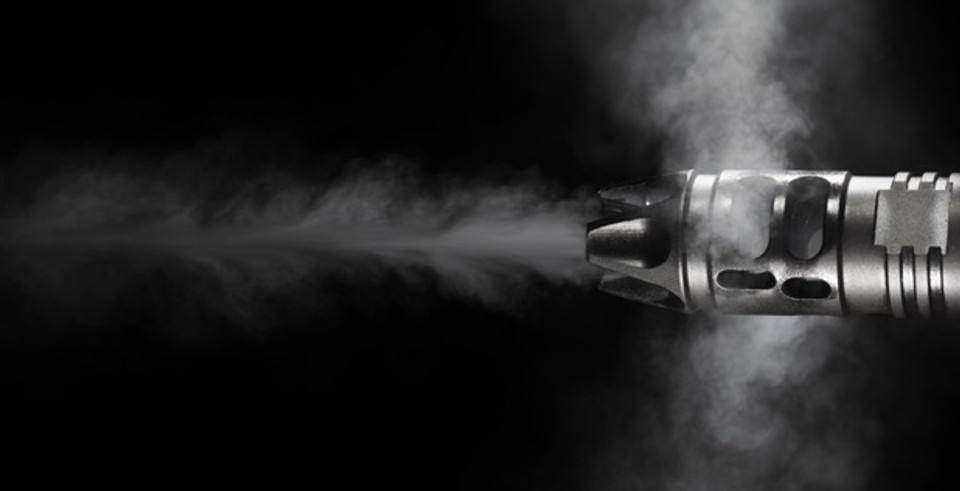AR15 complete uppers come with barrels, usually installed on the upper receiver. If not, it’s not a complete upper.
Your barrel is either going to be threaded or unthreaded. Pay close attention to this because if the barrel is threaded you will want to mount a muzzle device or a thread protector (see below).
Usually, a threaded barrel will either come with a thread protector or one of the following three muzzle devices.
Here’s what you need to know about each.
Suppressors: AKA Silencers, AKA “Cans”
Suppressors are an NFA item, which means they are regulated by the National Firearms Act. as a result, your AR15 complete upper is less likely to come with one of these than with a muzzle brake or flash hider.
However, if you apply for the tax stamp, and your state allows it, you may be able to get a suppressor for your AR15.
As you might have guessed from their more common name, “silencers” are used for muzzle volume reduction - that is, they make rifles shoot more quietly.
Some hunters and high-volume shooters prefer this as it protects their hearing, which is the main reason suppressors are so popular.
One thing you will want to note about the use of a suppressor is this: they result in a lot more backpressure through the barrel and action, and force a lot more fouling into the gas system and action of the rifle.
As a result, your bolt carrier group’s gas rings will probably wear out faster if you run a suppressor. You will also need to clean your rifle much more frequently if you use one because suppressors trap a lot of fouling and blast it back through the action.

Muzzle Brakes (Called a Compensator on a Handgun)
Probably the most practical of all common muzzle devices are muzzle brakes, which, when installed on a handgun, are called compensators.
Muzzle brakes can be instrumental at reducing recoil on the rifles on which they are mounted. In fact, they can slash felt recoil by as much as 50% or more without adversely affecting shot power at all.
In a rifle like an AR15, chambered in .223 or 5.56, which are already very light-recoiling rounds, these effects are significant. A 5.56-chambered rifle with a muzzle brake produces almost no felt recoil whatsoever.
The principle of operation of a muzzle brake is actually quite simple. Rather than allowing the barrel to direct all gasses and unburnt propellant forward, a muzzle brake distributes it more or less evenly around the muzzle, or upward at the muzzle, pushing it down.
This redirects some of the forces of recoil in a vector other than right back into the shooter’s shoulder, and the effect is a substantial reduction in felt recoil.
This helps to “hold” the barrel down, hence the name sometimes applied to them “compensator”; they compensate for recoil and muzzle rise.
Consequently, muzzle brakes can also substantially reduce muzzle rise, which helps keep the sights trained on target, requiring less obstruction to the sight picture, less correction between shots, and faster, more accurate follow up shots.
Flash Hiders
Flash hiders are arguably the most popular of muzzle devices, due to the fact that they are affordable and easy to install. However, in most applications, they are somewhat limited in utility.
The principle of operation for basically all flash hiders is effectively the same as a muzzle brake or a compensator; they redirect gasses and unburned propellant ported at the muzzle.
However, in the case of a flash hider, the purpose is not to reduce felt recoil, but to obscure the shooter’s muzzle flash, hence the name.
Flash hiders can be highly effective at concealing a shooter’s muzzle flash, especially with rifles with shorter barrels, where muzzle flash can be more pronounced.
This feature of flash hiders can be valuable in combat environments in which a muzzle flash can betray a shooter’s position. They can also be practical during use in tactical nighttime drills, when hunting at night, or in other low-light conditions.
Some shooters probably also use flash hiders because of the “tacticool” look they offer the platform, which is unrelated to the functionality of the device itself.
Otherwise, their utility is somewhat limited.
A Note on Thread Protectors
If you’re not used to shooting a threaded barrel, but the AR15 complete upper you wanted came with one, then one thing you have to remember to do is never to shoot or carry the rifle without a thread protector installed.
Threads are fine, delicate components, and are easily damaged through incidental contact. Your rifle probably came with a thread protector, but if not, and it has a threaded barrel, get one and install it.
Buffer Weights and Recoil Reduction
One final note is that you don’t need a muzzle device like a muzzle brake to reduce recoil. There are other things you can do, such as tinkering with the gas system (not advisable unless you know what you’re doing) or adjusting the buffer tube weight.
Although not part of the upper assembly, a standard buffer weight (housed within the buffer tube that attaches to the lower) is 3 ounces.
If you find your rifle kicks a bit much for you, consider upping the buffer weight to a heavier buffer weight. Two heavier alternatives to a standard buffer weight are H1 (3.8oz) and H2 (4.6oz) buffer weights.
Increasing the buffer weight will increase the reciprocating mass of the rifle, which in effect requires the bolt carrier group to recoil into a heavier obstacle before recoil is transferred to your shoulder.
Ultimately, increasing the buffer weight will decrease felt recoil. If you don’t want to install a muzzle brake, mess with the gas system, or change the ammo you shoot, consider adding a heavier buffer weight to get achieve similar effects.
Your AR15 Complete Upper Is Here

We carry a wide range of AR15 complete uppers, as well as threaded and unthreaded barrels that you can use for customizations or piecemeal builds.
In addition to barrels (of a range of barrel lengths) and complete assembled uppers, we also carry muzzle devices, bolt carrier groups, triggers, handguards and rail systems, buffer tubes and parts, along with pretty much everything else you could need for a home build.
If you have any questions before getting started, get in touch with us at Sales@MCSGearup.com.

